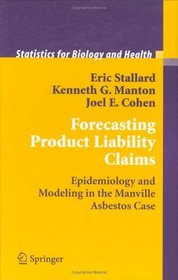Search -
Forecasting Product Liability Claims : Epidemiology and Modeling in the Manville Asbestos Case (Statistics for Biology and Health)
Forecasting Product Liability Claims Epidemiology and Modeling in the Manville Asbestos Case - Statistics for Biology and Health
Author:
This volume presents a rigorous account of statistical forecasting efforts that led to the successful resolution of the Johns-Manville asbestos litigation. This case, taking 12 years to reach settlement, is expected to generate nearly 500,000 claims at a total nominal value of over $34 billion. The forecasting task, to project the number, timing... more »
Author:
This volume presents a rigorous account of statistical forecasting efforts that led to the successful resolution of the Johns-Manville asbestos litigation. This case, taking 12 years to reach settlement, is expected to generate nearly 500,000 claims at a total nominal value of over $34 billion. The forecasting task, to project the number, timing... more »
ISBN-13: 9780387949871
ISBN-10: 0387949879
Publication Date: 10/25/2004
Pages: 394
Rating: ?
ISBN-10: 0387949879
Publication Date: 10/25/2004
Pages: 394
Rating: ?
0 stars, based on 0 rating
Genres:
- Health, Fitness & Dieting >> Diseases & Physical Ailments >> Cancer >> Lung Cancer
- Science & Math >> Mathematics >> Applied >> Probability & Statistics
- Law >> Administrative Law >> General
- Medicine >> Research >> Biostatistics
- Medicine >> Internal Medicine >> Infectious Disease >> Epidemiology
- Engineering & Transportation >> Professional Science >> Mathematics >> Applied >> Statistics
- Engineering & Transportation >> Law >> Administrative Law >> General
- Medical Books >> Medicine >> Internal Medicine >> Epidemiology




